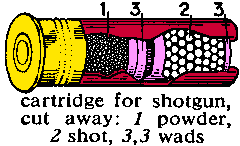A few years ago I
had the Republic Metallic Cartridge Company (specialized in loaded
black powder ammo) load some 10 and 12 gauge ammo with OO ought
buckshot for a shooting demonstration at the yearly WOLA convention
that was being held in Sierra Vista, Arizona. I spoke with the owner of
the ammunition company and told him I wanted standard off the shelf OO
ought (or "aught") buckshot loads (each pellet is .33 caliber) someone
could buy in the 1880's, because they were going to be shot in
original period pieces: an 1880's Ithaca - Baker Model, 10 gauge double
barrel hammer shotgun and an 1880's Belgium Occidental Model, 12 gauge
double barrel hammer shotgun. Both of these shotguns have 20 " barrel
lengths. The loads were as follows: 12 gauge, 2-1/2 inch length shell
with 3 drams of " Swiss " 2F black powder and 9 pellets of OO ought
buckshot using fiber cards and wad (no modern plastic shot cups). 10
gauge, 2-7/8 inch length shell with 4-1/4 drams of "Swiss" 2F black
powder and 12 pellets of OO ought buckshot using fiber cards and wad (no modern plastic shot cups).
Many folks feel that Doc Holliday may have used a 12 gauge with 12 pellets of OO ought buckshot loaded in his shotgun shells when shooting Tom McLaury at the infamous "Gunfight at the O.K. Corral" in Tombstone, Arizona, on October 26, 1881. So upon dissecting these Republic Metallic Cartridge Company shells, I found that there was no extra room to be had within the old west standard 2-1/2 inch length 12 gauge shell to add 3 more pellets if I wanted to shoot a 12 pellet OO buckshot load without substantially reducing the powder charge. I'm sure a lighter powder charge with 12 pellets of OO buckshot could be had, but your penetration factor would be substantially compromised. A 3 dram charge of black powder was considered a "normal" charge for a 12 gauge shotgun and you'd want at least a "normal" to a "heavy" powder charge when shooting men with OO buckshot pellets. Now if Doc in fact was using a smaller size of buckshot, such as number 1 (.30 cal) , 2 (.27 cal) or 3 (.25 cal) buckshot, you could get 12 pellets into the shotgun shell without lowering your 3 dram powder charge.
While at work on Wednesday 8-18-10 at 10:00 am, I conducted my pre-test shots to determine what distance from each shotgun would produce a pattern that could be covered by a man's hand (i.e. Dr Mathews, who examined McLaury); but how big was his hand? In my case, I wear men's gloves that are rated at size large. So for pre-testing, I used my hand as a visual aide and a measuring tape to get the actual diameter of the pattern. The first shots were fired at 11.5 feet to determine how well these short barreled shotguns would spread a shot pattern at a fairly close range. With the 12 gauge I got a 2 1/4" pattern and with the 10 gauge I got a 2" pattern, both of which could easily be covered by my hand. The next shots were fired at a distance I felt would give a more realistic pattern spread about the size of a man's hand; 21 feet or 7 yards. With both the 10 & 12 gauge I got patterns that were 3 1/2" in diameter, a size I was just barely was able to cover with my hand. The last 2 shots were from 30 ft to see how far that shot would spread from that 10 yd mark. The 12 gauge produced a 5 1/2" diameter pattern, while the 10 gauge produced a 6 3/4" diameter pattern. Throughout the testing, I was surprised as to how tight a pattern these 20" barreled black powder shotgun kept. I have seen many a modern police shotgun with a 20" barrel shoot much larger patterns at the same distances with modern smokeless powder and OO buckshot. I also noticed throughout my testing that the wadding (it's a dense fiber material) which goes on top of the "over the powder card" was also producing a large hole in my pre-testing targets; since Dr. Matthews did not mention any wounds other than the 12 buckshot entry wounds, I decided that during my actual testing I'd be covering the targets with heavy cotton shirts to see if that would stop the heavy wadding from penetrating the target.
While at work on Friday 8-20-10 at 2:00 pm, I conducted my test shots at 2 different distances that were likely to produce a shot pattern that could be covered by my hand. The targets were covered with heavy cotton fiber shirts, the kind that would be worn during cold weather while working outdoors. The first shots were fired at 21 ft or 7 yds with both the 10 & 12 gauge shot patterns I was barely able to cover the impact area with my hand. The wadding with the 12 gauge bounced off of the shirt, while the 10 gauge wadding went through the shirt and target. The second set of shots were fired at 18 ft and that 2 feet closer produced much tighter patterns. I could easily cover the 10 & 12 gauge impact areas with my hand. Again, the wadding with the 12 gauge bounced off of the shirt, while the 10 gauge wadding went through the shirt and target. So if Doc used a 10 gauge, either the wound produced by the wadding was not noted or, due to the flexibility of the human body, the wadding bounced off of Tom McLaury's side. My vote is for the 10 gauge shotgun at a distance of between 18 and 21 feet.
So what does this prove? Absolutely nothing, due to the unknowns in this situation; i.e. unknown shotgun gauge, unknown barrel length, unknown bore choke - if any, unknown powder charge, unknown powder granulation - 1F or 2F, unknown size of buckshot projectiles, was Tom McLaury wearing any outer upper body garments other than his shirt.
............................... but I had fun doing it !!!
Randy
Many folks feel that Doc Holliday may have used a 12 gauge with 12 pellets of OO ought buckshot loaded in his shotgun shells when shooting Tom McLaury at the infamous "Gunfight at the O.K. Corral" in Tombstone, Arizona, on October 26, 1881. So upon dissecting these Republic Metallic Cartridge Company shells, I found that there was no extra room to be had within the old west standard 2-1/2 inch length 12 gauge shell to add 3 more pellets if I wanted to shoot a 12 pellet OO buckshot load without substantially reducing the powder charge. I'm sure a lighter powder charge with 12 pellets of OO buckshot could be had, but your penetration factor would be substantially compromised. A 3 dram charge of black powder was considered a "normal" charge for a 12 gauge shotgun and you'd want at least a "normal" to a "heavy" powder charge when shooting men with OO buckshot pellets. Now if Doc in fact was using a smaller size of buckshot, such as number 1 (.30 cal) , 2 (.27 cal) or 3 (.25 cal) buckshot, you could get 12 pellets into the shotgun shell without lowering your 3 dram powder charge.
While at work on Wednesday 8-18-10 at 10:00 am, I conducted my pre-test shots to determine what distance from each shotgun would produce a pattern that could be covered by a man's hand (i.e. Dr Mathews, who examined McLaury); but how big was his hand? In my case, I wear men's gloves that are rated at size large. So for pre-testing, I used my hand as a visual aide and a measuring tape to get the actual diameter of the pattern. The first shots were fired at 11.5 feet to determine how well these short barreled shotguns would spread a shot pattern at a fairly close range. With the 12 gauge I got a 2 1/4" pattern and with the 10 gauge I got a 2" pattern, both of which could easily be covered by my hand. The next shots were fired at a distance I felt would give a more realistic pattern spread about the size of a man's hand; 21 feet or 7 yards. With both the 10 & 12 gauge I got patterns that were 3 1/2" in diameter, a size I was just barely was able to cover with my hand. The last 2 shots were from 30 ft to see how far that shot would spread from that 10 yd mark. The 12 gauge produced a 5 1/2" diameter pattern, while the 10 gauge produced a 6 3/4" diameter pattern. Throughout the testing, I was surprised as to how tight a pattern these 20" barreled black powder shotgun kept. I have seen many a modern police shotgun with a 20" barrel shoot much larger patterns at the same distances with modern smokeless powder and OO buckshot. I also noticed throughout my testing that the wadding (it's a dense fiber material) which goes on top of the "over the powder card" was also producing a large hole in my pre-testing targets; since Dr. Matthews did not mention any wounds other than the 12 buckshot entry wounds, I decided that during my actual testing I'd be covering the targets with heavy cotton shirts to see if that would stop the heavy wadding from penetrating the target.
While at work on Friday 8-20-10 at 2:00 pm, I conducted my test shots at 2 different distances that were likely to produce a shot pattern that could be covered by my hand. The targets were covered with heavy cotton fiber shirts, the kind that would be worn during cold weather while working outdoors. The first shots were fired at 21 ft or 7 yds with both the 10 & 12 gauge shot patterns I was barely able to cover the impact area with my hand. The wadding with the 12 gauge bounced off of the shirt, while the 10 gauge wadding went through the shirt and target. The second set of shots were fired at 18 ft and that 2 feet closer produced much tighter patterns. I could easily cover the 10 & 12 gauge impact areas with my hand. Again, the wadding with the 12 gauge bounced off of the shirt, while the 10 gauge wadding went through the shirt and target. So if Doc used a 10 gauge, either the wound produced by the wadding was not noted or, due to the flexibility of the human body, the wadding bounced off of Tom McLaury's side. My vote is for the 10 gauge shotgun at a distance of between 18 and 21 feet.
So what does this prove? Absolutely nothing, due to the unknowns in this situation; i.e. unknown shotgun gauge, unknown barrel length, unknown bore choke - if any, unknown powder charge, unknown powder granulation - 1F or 2F, unknown size of buckshot projectiles, was Tom McLaury wearing any outer upper body garments other than his shirt.
............................... but I had fun doing it !!!
Randy
Anatomy of shotgun shell
Pre-Test shooting (08/18/2010)
Click to view full size images - Images are large and may take several seconds to load
Test shooting (08/20/2010)
Click to view full size images - Images are large and may take several seconds to load

